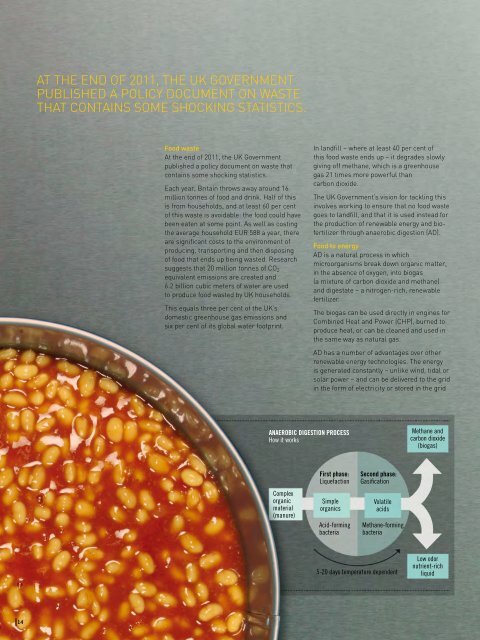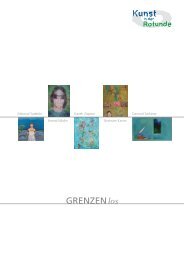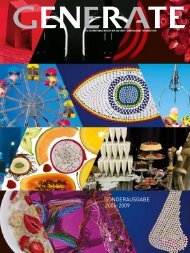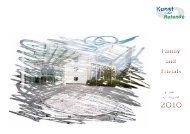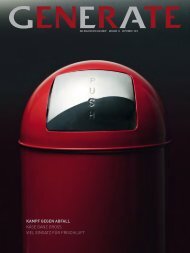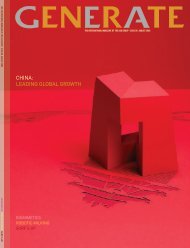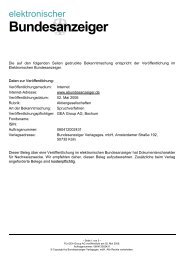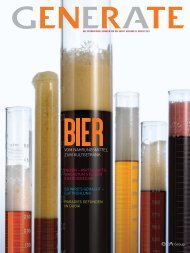A BREATH OF FRESH AIR SAY CHEESE WAR ON ... - GEA Group
A BREATH OF FRESH AIR SAY CHEESE WAR ON ... - GEA Group
A BREATH OF FRESH AIR SAY CHEESE WAR ON ... - GEA Group
You also want an ePaper? Increase the reach of your titles
YUMPU automatically turns print PDFs into web optimized ePapers that Google loves.
14<br />
AT THE END <strong>OF</strong> 2011, THE UK GOVERNMENT<br />
PUBLISHED A POLICY DOCUMENT <strong>ON</strong> WASTE<br />
THAT C<strong>ON</strong>TAINS SOME SHOCKING STATISTICS.<br />
Food waste<br />
At the end of 2011, the UK Government<br />
published a policy document on waste that<br />
contains some shocking statistics.<br />
Each year, Britain throws away around 16<br />
million tonnes of food and drink. Half of this<br />
is from households, and at least 60 per cent<br />
of this waste is avoidable: the food could have<br />
been eaten at some point. As well as costing<br />
the average household EUR 588 a year, there<br />
are significant costs to the environment of<br />
producing, transporting and then disposing<br />
of food that ends up being wasted. Research<br />
suggests that 20 million tonnes of CO 2<br />
equivalent emissions are created and<br />
6.2 billion cubic meters of water are used<br />
to produce food wasted by UK households.<br />
This equals three per cent of the UK’s<br />
domestic greenhouse gas emissions and<br />
six per cent of its global water footprint.<br />
AnAErobic diGEstion procEss<br />
How it works<br />
Complex<br />
organic<br />
material<br />
(manure)<br />
In landfill – where at least 40 per cent of<br />
this food waste ends up – it degrades slowly<br />
giving off methane, which is a greenhouse<br />
gas 21 times more powerful than<br />
carbon dioxide.<br />
The UK Government’s vision for tackling this<br />
involves working to ensure that no food waste<br />
goes to landfill, and that it is used instead for<br />
the production of renewable energy and biofertilizer<br />
through anaerobic digestion (AD).<br />
Food to energy<br />
AD is a natural process in which<br />
microorganisms break down organic matter,<br />
in the absence of oxygen, into biogas<br />
(a mixture of carbon dioxide and methane)<br />
and digestate – a nitrogen-rich, renewable<br />
fertilizer.<br />
The biogas can be used directly in engines for<br />
Combined Heat and Power (CHP), burned to<br />
produce heat, or can be cleaned and used in<br />
the same way as natural gas.<br />
AD has a number of advantages over other<br />
renewable energy technologies. The energy<br />
is generated constantly – unlike wind, tidal or<br />
solar power – and can be delivered to the grid<br />
in the form of electricity or stored in the grid<br />
First phase:<br />
Liquefaction<br />
Simple<br />
organics<br />
Acid-forming<br />
bacteria<br />
second phase:<br />
Gasification<br />
Volatile<br />
acids<br />
Methane-forming<br />
bacteria<br />
5-20 days temperature dependent<br />
Methane and<br />
carbon dioxide<br />
(biogas)<br />
Low odor<br />
nutrient-rich<br />
liquid


